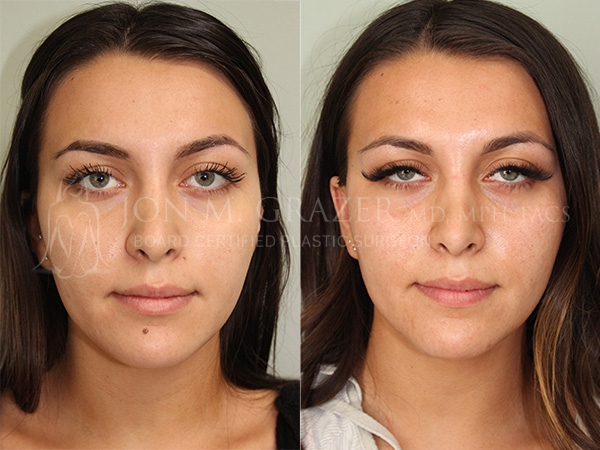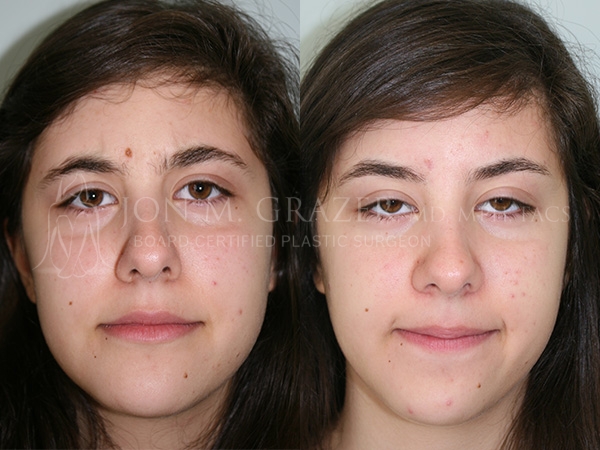Mole Removal in Newport Beach
Beautify Enhance Renew
Mole Removal in Newport Beach
Most adults have a number of moles on their bodies. These are usually benign (not harmful). Many people ignore their moles, and some even embrace them as glamorous or charming features. However, sometimes a mole grows in an undesirable or uncomfortable region of the body. Alternatively, a mole may exhibit suspicious characteristics that can be concerning and warrant medical attention.
Dr. Grazer offers safe and effective mole removal in Newport Beach so you can love the skin you’re in.

Model
What Is a Mole?
A mole is a small spot on the skin, usually a shade of brown, pink, or black, caused by a cluster of pigment-producing cells (melanocytes). Moles are typically round but can be flat or slightly raised. Most of the time, they’re harmless. However, if a mole changes color or shape, starts bleeding, or becomes itchy, it could be a sign of cancer and requires immediate attention.
It’s a good idea to be aware of the moles you have and keep an eye on them to spot sudden changes in appearance.
What Is Mole Removal?
Mole removal is an outpatient medical procedure that removes a mole from the skin, either for cosmetic reasons or as a cancer prevention measure.
Most moles can be safely left alone. However, if you are unhappy with the way a mole looks or feels or with its location on the body, you can have it surgically removed.
If a mole is atypical (with uneven edges, uneven color, or a changing appearance), it may need to be removed and screened for cancer.
Mole Removal Benefits
Many patients wish to have a mole removed for aesthetic reasons. Having a mole removed professionally can result in a more even appearance of the skin and increased comfort. If the mole was on your face, your other facial features may stand out more after having the mole removed, and you may notice better facial balance and harmony alongside your smoother complexion.
A major non-cosmetic benefit of a mole removal procedure is the ability to test the mole for skin cancer. If it turns out the mole was cancerous and you need skin cancer treatment beyond mole removal, you can begin treatment right away, reducing the chances that cancer will spread to other body parts.
Am I a Candidate for Mole Removal?
If you are unhappy with the way a mole affects your appearance, find it painful or uncomfortable, or suspect it may be precancerous or cancerous, you are likely a candidate for mole removal.
Good candidates should be in good health and have realistic expectations for results.
To find out if mole removal is the right treatment for you, schedule a consultation with Dr. Grazer’s office by calling (949) 644-1240.
Types of Moles and Skin Tags
Skin Tag
Skin tags are flesh-colored growths that protrude from the surface of the skin. They are soft (unlike the harsh texture of a wart, for example) and can grow in clusters. They often develop in areas where skin friction occurs, like the neck, underarms, groin, or under the breasts. They are more common in people after weight gain or in middle age. Skin tags are usually harmless and can be easily removed with surgical or shave excision techniques, as they exist purely above the epidermis.
Seborrheic Keratosis
These are common skin growths, similar to moles. Seborrheic keratoses are rounded or oval in shape, can be waxy or scaly in appearance, and can appear “stuck on” the skin. They are often brown but can also be black, tan, or, less commonly, pink, yellow, or white. While moles stem from melanocytes, seborrheic keratoses are thought to originate from an overgrowth of keratinocytes.
Non-cancerous Moles
Moles are clusters of extra cells on the outer layer of the skin and can have roots below the skin’s surface. They can be flat or slightly raised, usually have a smooth, round edge, and are often brown in color, but they can also be tan, pink, or skin-toned. Benign moles typically don’t noticeably change over time.
Cancerous Moles
Cancerous or precancerous moles—also known as atypical moles, malignant moles, or melanomas—can develop from an existing mole or appear on seemingly normal skin.
These can be hard to categorize because they come in all shapes and sizes. They can be dark in color, or they can be pink, red, white, skin-toned, or clear. They can show up in hard-to-spot areas like under fingernails or toenails, on the palms of the hands, or on the soles of the feet.
It’s a good idea to watch for new moles or freckles, sore spots that don’t heal, existing moles that start changing, growing, or itching, or any spot or lesion that looks unusual. The ABCDE Guide in the FAQ below can help you recognize melanoma warning signs.
Mole and Skin Tag Removal in Newport Beach
Mole Removal Consultation
The process of having a mole or skin tag removed will begin with a consultation. At this consultation, Dr. Grazer will ask you questions, including how long you’ve had the mole and whether it has changed over time. He will then examine the mole carefully and may take pictures.
If Dr. Grazer determines that he can safely remove the mole, he will create a treatment plan and set a date for your appointment. The benefit of coming to our office for mole removal is that we can customize your treatment plan to your goals, adding treatments like laser facial rejuvenation or microneedling to further enhance your complexion.
Preparing for Mole Removal
Mole removal is usually a straightforward procedure and doesn’t require much preparation.
At your consultation, Dr. Grazer will provide you with detailed instructions on how to prepare for your mole removal. These may include:
- Discontinuing the use of blood thinners
- Arriving with clean skin
- Eat and drink something before your appointment
You may also want to make preparations based on the location of your mole. Removal of a mole on the foot, for example, may make it difficult to drive yourself home after the procedure.
How Are Moles Removed?
Moles and birthmarks alike are often approached with similar treatments, as these marks are close to the surface of the skin. The best treatment will be tailored to your needs and the particular mole or birthmark your skin is presenting with.
Surgical Excision
For larger, darker, deeper, or precancerous moles, surgical excision may be recommended. During a surgical removal, the area below the mole is numbed with an anesthetic to ensure that there is no pain. This will also cause a mole or birthmark to rise, allowing for easier removal. Your birthmark or mole will then be removed with a sharp blade. For precancerous or cancerous moles, a margin of tissue may also be removed to ensure patient safety. Depending on the size and placement of the mole, stitches may or may not be necessary. Once the wound stops bleeding, it will be covered with a sterile bandage.
Laser Treatment
Dr. Grazer uses the VersaPulse® laser system for laser mole removal. Green-light wavelengths target the lesion while leaving the surrounding skin and tissues intact, causing minimal downtime and bruising. This method is suitable for benign moles but is still less common than surgical excision, as the tissue cannot be tested for cancer.
What Should I Expect After Mole Removal?
Recovery after mole removal depends on the patient’s health and the size of the mole removed. The wound must be kept clean, moist, and protected. Dr. Grazer will provide instructions for proper wound care.
It can take two to three weeks to heal completely from mole removal. However, you should be able to return to your daily activities right away and even drive yourself home.
Mole Removal Results
Mole removal usually yields good, long-lasting results that patients are satisfied with. The procedure may leave a small scar. This scar should fade over time, but if not, it often will respond well to skin rejuvenation treatments like laser resurfacing, microneedling, or chemical peels for a flawless finish.
After your skin heals fully, it’s essential to use sunscreen to protect the skin when you’re outside during the day. If you notice anything unusual at the site where the mole was removed, contact Dr. Grazer right away.
How Much Does Mole Removal Cost?
The cost of mole removal varies depending on the size and location of the mole, the removal technique, and other factors. To learn more about mole removal costs, please contact our office. At your consultation, our team will be happy to provide you with further information about pricing and financing and answer any additional questions you may have.
Frequently Asked Questions About Mole Removal
What is the “ABCDE” guide to recognizing possible cancerous moles?
If you notice any of the following about a particular mole, schedule an appointment with Dr. Grazer for a complete evaluation:
- A: Asymmetrical. Benign moles have smooth borders and a circular shape. Moles with uneven borders or an irregular shape could be cancerous.
- B: Border. Moles with scalloped or jagged borders should be checked by a physician as soon as possible.
- C: Color. Normal moles are typically brown or dark brown. A mole that is multi-colored (brown, black, tan, reddish-pink) is not normal.
- D: Diameter. Large moles with a diameter of one-quarter inch or more should be checked by a doctor, even if it is symmetrical.
- E: Evolving. Non-cancerous moles should not noticeably change their size, color, or shape over time.
My father and grandfather had melanoma. Should I be worried about developing melanoma?
Scientists speculate that certain types of problematic moles can be inherited, but aren’t sure whether melanoma is genetic. Familial malignant melanoma is a clinical term that refers to families with at least two relatives (sibling, parent, grandparents) diagnosed with melanoma.
Dysplastic nevi moles are frequently seen in families with a history of melanoma. Mostly found on the shoulders, upper back, and face, dysplastic nevi moles are asymmetric, larger than normal, and unusually pigmented.
What kind of test can accurately diagnose a malignant mole?
A skin biopsy is the most reliable method for determining if a mole is precancerous or cancerous. The biopsy will either be a complete removal of the mole or a punch biopsy that involves removing a section deep inside the mole.
When viewed under a microscope, melanoma cells are either spindle cells or epithelioid cells. These cells indicate superficial spreading of melanoma or melanoma that has reached the nodular (aggressive) stage.


